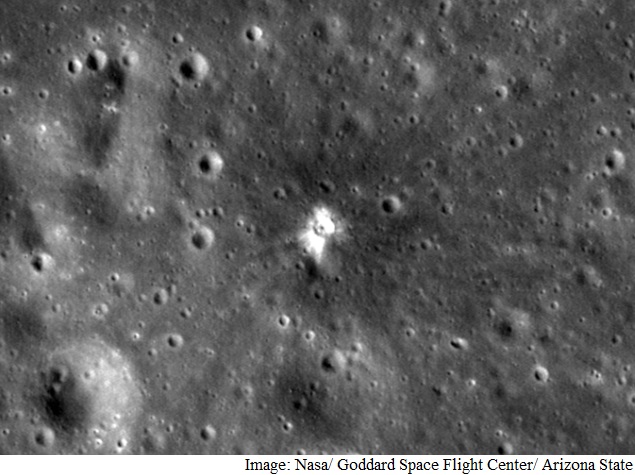- Home
- Science
- Science News
- Nasa Orbiter Captures Brightest Recorded Explosion on Moon
Nasa Orbiter Captures Brightest Recorded Explosion on Moon

On March 17, an object with the size of a small boulder hit the lunar surface and exploded in a flash of light nearly 10 times as bright as anything ever recorded before.
This bright flash was recorded by researchers at Nasa's Marshall Space Flight Centre in Huntsville.
Comparing the actual size of the crater to the brightness of the flash will help validate impact models, the US space agency said in a statement.
The crater itself is small, measuring 61.7 feet in diameter, but its influence is large. Debris excavated by the sudden release of energy flew for hundreds of metres.
More than 200 related surface changes up to 30 km away were noted, said the report published in the journal Icarus.
The impact crater is one of thousands of craters being mapped by the instrument.
The LRO team is going back to images taken in the first year or two and comparing them with recent images.
Called temporal pairs, these before/after images enable the search for a range of surface changes, including new impact craters formed between the time the first and second images were acquired.
Launched on June 18, 2009, LRO has collected a treasure trove of data with its seven powerful instruments, making an invaluable contribution to our knowledge about the moon.
Get your daily dose of tech news, reviews, and insights, in under 80 characters on Gadgets 360 Turbo. Connect with fellow tech lovers on our Forum. Follow us on X, Facebook, WhatsApp, Threads and Google News for instant updates. Catch all the action on our YouTube channel.
Related Stories
- Samsung Galaxy Unpacked 2025
- ChatGPT
- Redmi Note 14 Pro+
- iPhone 16
- Apple Vision Pro
- Oneplus 12
- OnePlus Nord CE 3 Lite 5G
- iPhone 13
- Xiaomi 14 Pro
- Oppo Find N3
- Tecno Spark Go (2023)
- Realme V30
- Best Phones Under 25000
- Samsung Galaxy S24 Series
- Cryptocurrency
- iQoo 12
- Samsung Galaxy S24 Ultra
- Giottus
- Samsung Galaxy Z Flip 5
- Apple 'Scary Fast'
- Housefull 5
- GoPro Hero 12 Black Review
- Invincible Season 2
- JioGlass
- HD Ready TV
- Laptop Under 50000
- Smartwatch Under 10000
- Latest Mobile Phones
- Compare Phones
- OnePlus 15R
- Realme Narzo 90x 5G
- Realme Narzo 90 5G
- Vivo S50 Pro Mini
- Vivo S50
- OPPO Reno 15c
- Redmi Note 15 5G
- Redmi Note 15 Pro 5G
- Asus ProArt P16
- MacBook Pro 14-inch (M5, 2025)
- Infinix Xpad Edge
- OnePlus Pad Go 2
- OnePlus Watch Lite
- Just Corseca Skywatch Pro
- Acerpure Nitro Z Series 100-inch QLED TV
- Samsung 43 Inch LED Ultra HD (4K) Smart TV (UA43UE81AFULXL)
- Asus ROG Ally
- Nintendo Switch Lite
- Haier 1.6 Ton 5 Star Inverter Split AC (HSU19G-MZAID5BN-INV)
- Haier 1.6 Ton 5 Star Inverter Split AC (HSU19G-MZAIM5BN-INV)
-
 Santhana Prapthirasthu Now Streaming on Prime Video and JioHotstar: What You Need to Know
Santhana Prapthirasthu Now Streaming on Prime Video and JioHotstar: What You Need to Know
-
 Oppo Reno 15 Pro Mini India Launch and Key Specifications Tipped Online
Oppo Reno 15 Pro Mini India Launch and Key Specifications Tipped Online
-
 Samsung Galaxy Z Flip 8 Tipped to Feature Newly-Launched Exynos 2600 SoC
Samsung Galaxy Z Flip 8 Tipped to Feature Newly-Launched Exynos 2600 SoC
-
 Dawood Now Streaming Online: A Crime Comedy Thriller with Twists, Chaos, and Dark Humour
Dawood Now Streaming Online: A Crime Comedy Thriller with Twists, Chaos, and Dark Humour










